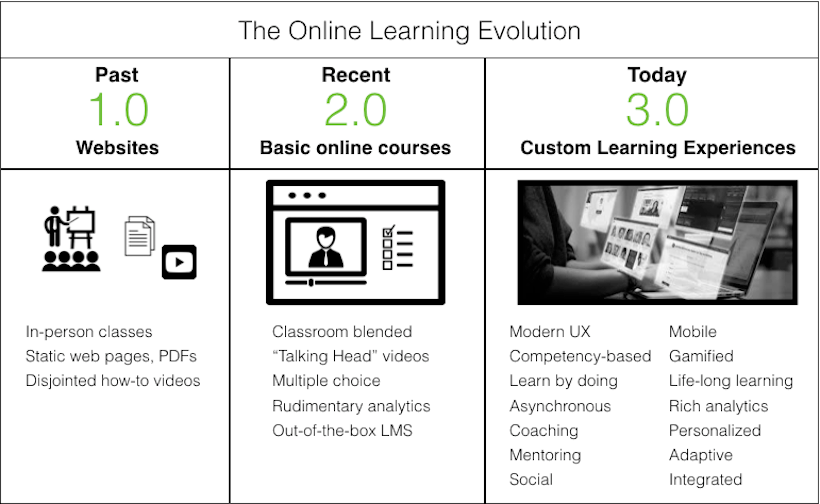Improving Corporate Online Learning Success Through Improving Learner Attitude and Organizational Support
The benefits of training and learning in the corporate scenario are undisputed. It is not surprising that many organizations make considerable efforts to create training initiatives to make sure that their employees are at par with the developments around them. A lot of funds are also directed towards creating sustainable as well as impactful trainings that benefit the employees as well as the organization, in the long run.
But training initiatives often fail to make the anticipated impact. This is a waste of time as well as effort of the learners; and, furthermore, a waste of organizational funds as well. Digging into the reasons why a training initiative fails, the two main culprits are: Firstly, the learners’ apathy towards learning and secondly, lack of organizational support.
Improving Learners’ Attitude Towards Corporate Online Learning
Many learners’ view Online learning as a ‘necessary evil’. They take up mandatory training programs that are required to advance within the company. This is where the negative attitude towards learning often originates. When the training is closely linked with organizational actions like employee evaluations or bonuses, it is a definite ‘push’ for learning. But it is important to note that the learners are only motivated by the reward and not the subject matter. Rather than something that they have to do as a mandatory task, learners must view learning as a task where they benefit directly.
There are ways to improve the learners’ attitude. These work for a variety of organizations:
- Highlight actual benefits of corporate online learning.
Most employees ask the same question when starting a training initiative -- “What’s in it for me?” If they perceive that the training is for organizational benefit only, it discourages them to put in their best efforts into learning. Thus, if the benefits of learning are pointed out to the individual before the start of the training endeavour, it can do a world of good to the end-results. Mailers or e-brochures can be created to highlight the benefits, and sent out to the learners. Mini-contests and other activities can also be held to create a buzz around the training initiative. Within the e-course, badges or certificates can be created to help the learners achieve goals and improve engagement with the learning process. - Encourage peer learning.
Learning is a social process and the best results are reaped when there are ample opportunities for peer interaction. But due to time restrictions, this is often not a viable option. But with technology-aided online learning platforms, learners can be given the opportunity to interact with fellow learners through instant messaging, discussion boards or even virtual classrooms. The social platform can also be utilized for peer learning, where advanced learners or high performers can be given the onus of leading discussions or even conducting short lessons for their peers. This is a huge driver for learning. It gives a sense of pride and achievement to the best performers within the learner group. For others it’s a source of inspiration that propels them to put in extra efforts and encourages them to aspire for the same achievements. - Personalized corporate online learning.
Learning is a personal experience, and every individual has a different learning style. It is not possible to build-in all the personal styles into a single training course. But it is important to give enough options to cater to some personal requirements as well. Contrary to popular belief, it is possible to build-in the avenues of personal learning without drilling a huge hole in your training budget! For instance, while building an e-course, G-cube created a structure that split the course into two – the first one, an introduction; the other. giving the details of the subject in hand. Advanced learners could choose to skip the first part and move on to the more pertinent second part. To make sure that all the learners do not skip the introduction, a small test was assigned at the beginning of the second part, which made sure that the learner had the necessary background to fully understand the subject ahead. The bifurcation within the course provided an option to the learners that helped them save time and effort. In addition, it provided them the opportunity to concentrate on newer knowledge while they did not have to forcibly study something they already knew.
Improving Organizational Support
The organization has to support the corporate online learning endeavor to reap the true ROI of the initiative. Organizations should develop a solid organizational program that provides choice to the employees by making available courses for individual learning needs as well as custom training courses for team learning and development needs. It is possible for the organization to do its bit and make sure that the corproate online learning initiative is not headed for failure:
- Defining training objectives.
As basic as it sounds, many training initiatives begin with no clear objectives in mind. Most of them are created to cater to a pertinent need within the organization, but how the employee can improve or can become more better-suited for his or work through learning remains unclear. For instance, when creating a training to improve the selling techniques of employees, the objective should take into account the improved sales figures of the learner group over time – both before and after commencement of training. By defining objectives, the organization makes the training ‘purposeful’ and thus gains the most out of it. - Training evaluation is critical.
Many organizations don’t direct enough efforts to evaluate how well employees have learned after they have completed a training course. Organizations should extend support to fully gauge the impact of training efforts that benefit employees as well as the organization. Some organizations simply rely on employee feedback to understand how well the training was received. But this only gives a measure of initial reaction to the course, which is often insufficient in measuring the true impact. Organizations should not only test the actual skills learned during the training, but do it on a continual basis. Also, it is necessary to test an employee immediately after the training and repeat the testing multiple times to measure the skills decay. This will provide the true impact of online learning and also reveal the training needs as and when they emerge. - Practice what is learned.
Measuring skills decay is important, but it is also necessary to take proper steps to avoid the loss of skills over time. It is common knowledge that 79% of information learnt is forgotten within a month, if nothing is done to reinforce it. So, the good news is that there are re-enforcement activities that can decrease loss of information over time as well as increase retention rates for the learners. Organizations should provide the learners ample opportunities to practice newly-acquired skills or knowledge. If this is not possible in actual place of work, assignments or workshops can be conducted to make sure that the learners can practice and perfect. Simulations can also be created to provide the learners a safe and secure environment for practicing before embarking on applying them in their work.
Employees are the greatest assets of an organization and employee development can be attained only if both parties are on board – employees as well as the organization. In the current competitive global market, the organizations who invest in employee training and development are the ones that succeed. Also, employees who realize the worth of giving their best towards employee training and development initiatives are the ones who succeed along with the organization.









